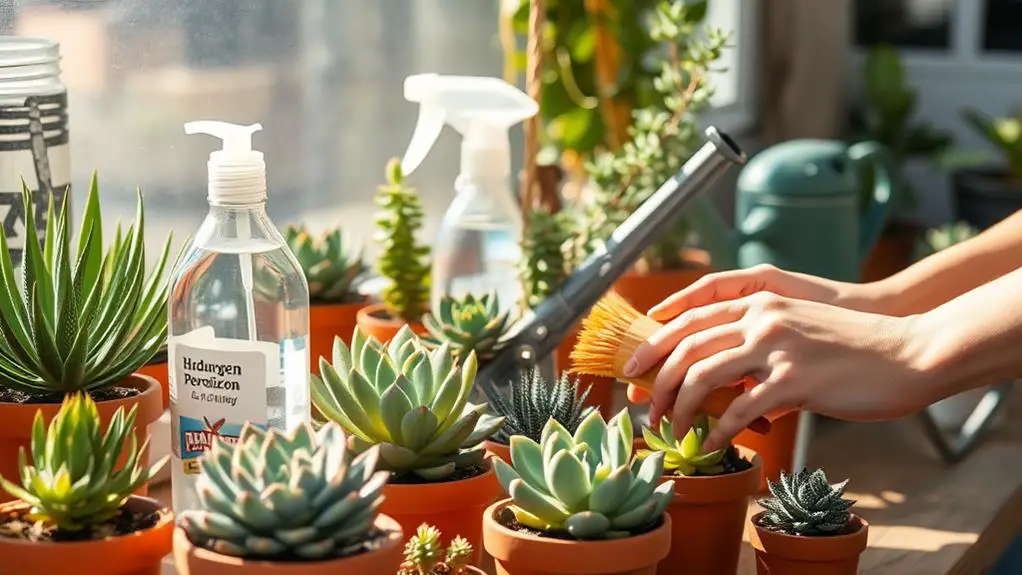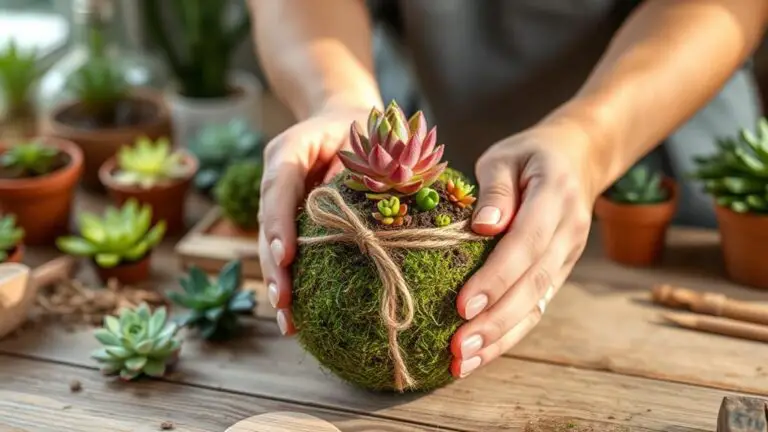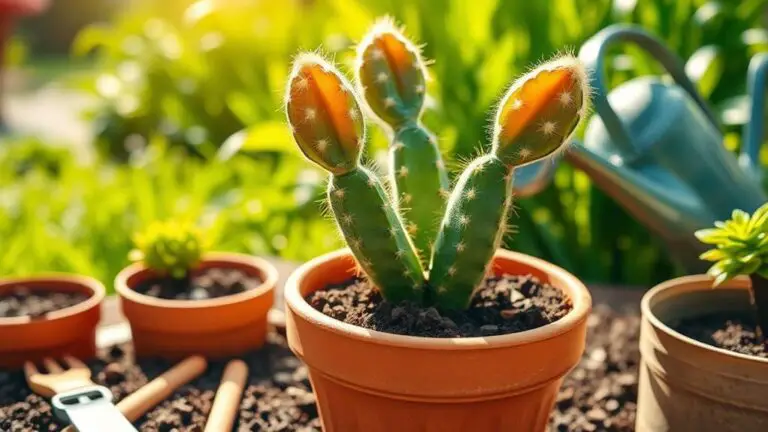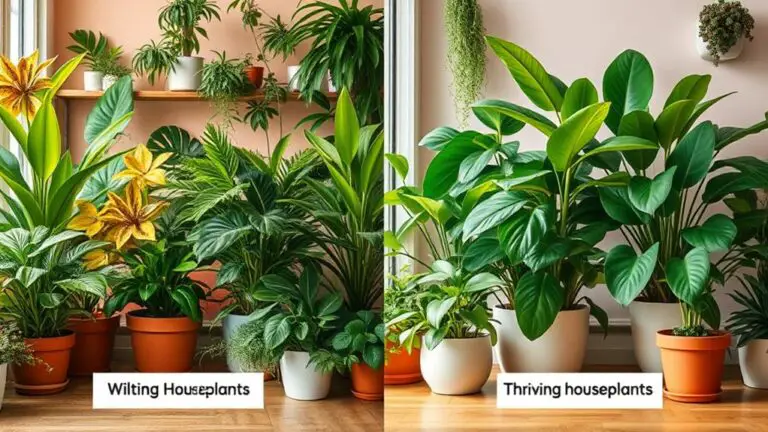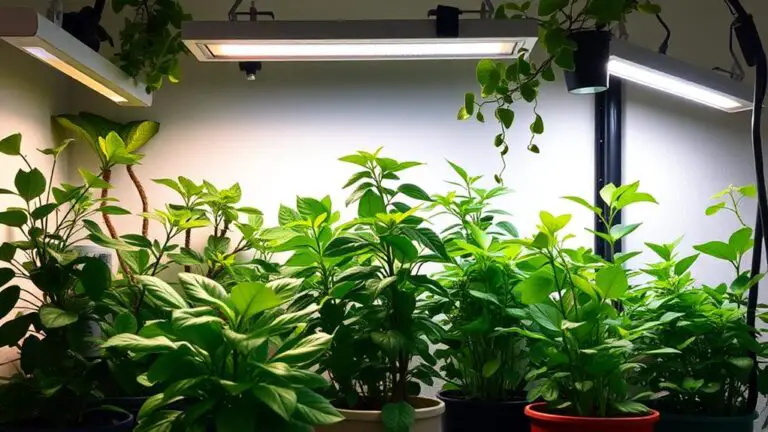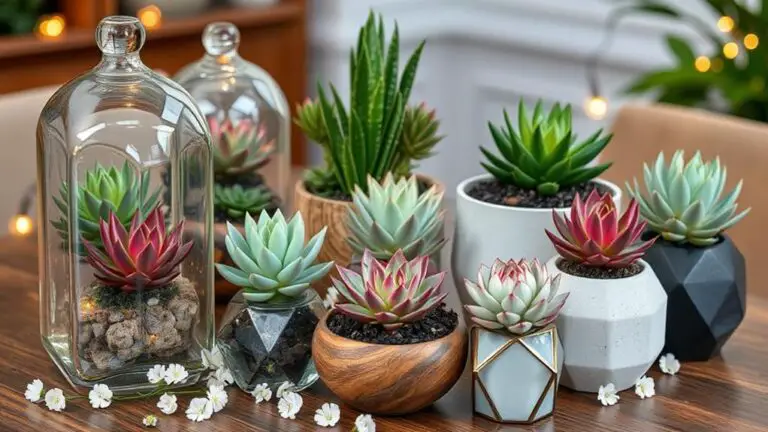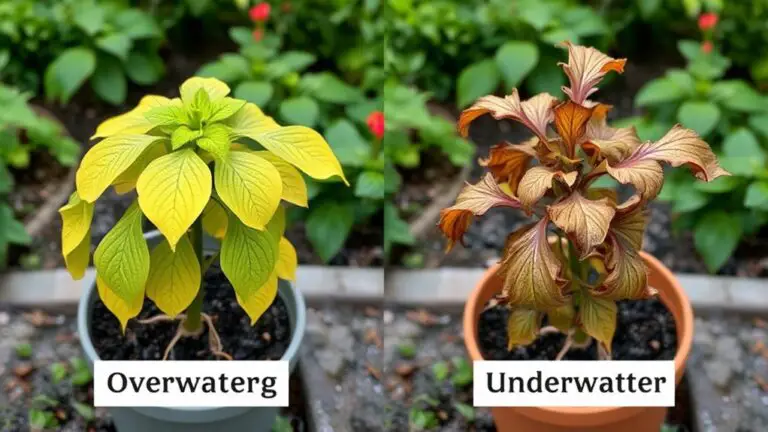7 Steps to Using Hydrogen Peroxide With Succulents
Using hydrogen peroxide with succulents can be a game-changer for your plant care routine, but knowing the right steps is vital. You'll start with a 3% hydrogen peroxide solution, which you should dilute properly for safe use. Once you've got your mix, it's important to inspect your succulents for any signs of pests or disease before applying the solution. This method can offer numerous benefits, but improper use can lead to problems. Curious about the best application techniques or common mistakes to avoid? Let's explore each step to guarantee your succulents thrive.
Understanding Hydrogen Peroxide
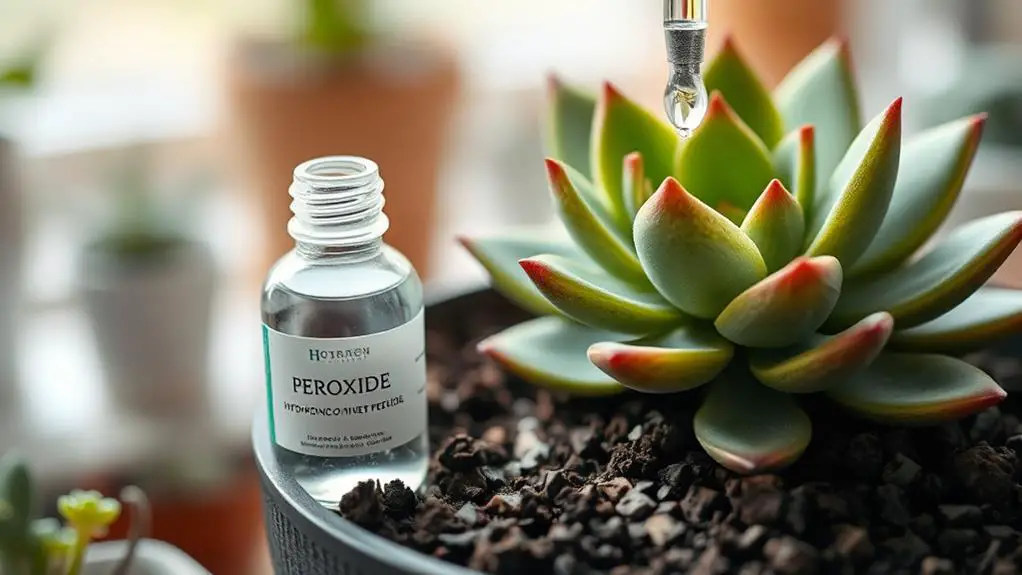
Hydrogen peroxide's unique composition, consisting of two hydrogen atoms and two oxygen atoms, makes it a powerful oxidizing agent. When you use it in your garden, particularly with succulents, it can be incredibly beneficial.
But first, it's important to understand how it works and why it's helpful.
Hydrogen peroxide (H2O2) is commonly available in diluted forms, typically ranging from 3% to 9%. For gardening and household use, a 3% solution is ideal. When you apply this solution to the soil, it breaks down into water and oxygen. This process helps improve soil health by adding extra oxygen, which is great for the roots of your plants.
To use hydrogen peroxide safely, you need to dilute it correctly. A common recommendation is to mix one part hydrogen peroxide with ten parts water. This dilution guarantees that the solution is gentle enough not to harm sensitive plant tissues.
As an antiseptic, hydrogen peroxide can also disinfect the soil, killing bacteria and fungi that might harm your plants.
Benefits for Succulents

When you incorporate hydrogen peroxide into your succulent care routine, you'll see several benefits that enhance plant health and growth. One of the major benefits of using hydrogen peroxide for plants is that it helps prevent fungal infections and bacterial problems. Its germicidal properties guarantee that your succulents stay healthy and vibrant.
Hydrogen peroxide also oxygenates soil, which boosts nutrient absorption through the roots. This additional oxygen molecule can improve overall plant liveliness and stimulate growth. If you're dealing with root rot, hydrogen peroxide can combat root decay by breaking down dead organic matter and killing harmful bacteria. This allows your succulents to develop healthier root systems.
Another advantage is that regular applications of diluted hydrogen peroxide can act as a natural pesticide, protecting your plants from pests like mealybugs and aphids. It's a safer alternative to chemical pesticides, keeping your garden eco-friendly.
If your succulents are stressed or overwatered, hydrogen peroxide can revitalize them. It improves soil oxygen levels, promoting recovery and healthier growth. When you trim away damaged parts, the hydrogen peroxide will support the healing process, guaranteeing your succulents thrive.
Proper Dilution Techniques

When using hydrogen peroxide with succulents, it's essential to get the dilution ratios right to avoid harming your plants.
For general use, mix 1 part hydrogen peroxide with 10 parts water, but you can use a stronger 1:5 solution for severe pest issues.
To keep your succulents healthy, apply the diluted solution once every two weeks, and always test it on a small area first.
Ideal Dilution Ratios
For effective use of hydrogen peroxide with succulents, understanding the ideal dilution ratios is crucial.
When using hydrogen peroxide solution for general maintenance, mix 1 part hydrogen peroxide to 10 parts water. This helps in keeping your plant roots healthy and preventing root rot.
If you're dealing with severe pest infestations, a stronger mix of 1 part hydrogen peroxide to 5 parts water is more effective.
For foliar applications, which means spraying the leaves, mix a 3% hydrogen peroxide solution with an equal amount of water. This 1:1 ratio works well against pests and fungal infections on your succulents.
If your plant roots are suffering from root rot, you need a slightly stronger blend. Use a 3% hydrogen peroxide solution mixed at a ratio of 1 part hydrogen peroxide to 2 parts water. This mix can help to revive the roots by killing harmful bacteria and fungi.
To boost soil oxygenation, mix 2.5 teaspoons of hydrogen peroxide into a gallon of water.
Always remember to test any diluted solution on a small area of the plant first. This guarantees you won't cause any unintended damage.
Application Frequency Guidelines
Maintaining the health of your succulents with hydrogen peroxide involves understanding the right frequency for application. To begin with, for regular maintenance, mix 1 part 3% hydrogen peroxide with 3 parts water. Apply this every 2-4 weeks to promote healthy growth and prevent diseases.
When you need hydrogen peroxide to treat pests or fungal infections, use a stronger solution of equal parts hydrogen peroxide and water. Spray it on your plants every 3-4 days until the problem is resolved.
If your succulents suffer from root rot, immerse the root ball in a solution of 1 part hydrogen peroxide to 2 parts water for 10-15 minutes. Afterward, rinse thoroughly with distilled water.
For enhancing seed germination, soak seeds overnight in a diluted solution of 1 part hydrogen peroxide to 32 parts water before planting.
Always watch for signs of stress in your plants and adjust the application frequency as needed. This helps cater to your plant needs effectively.
| Treatment Type | Dilution Ratio | Application Frequency |
|---|---|---|
| Regular Maintenance | 1:3 (H2O2:Water) | Every 2-4 weeks |
| Pests/Fungal Infections | 1:1 (H2O2:Water) | Every 3-4 days |
| Root Rot | 1:2 (H2O2:Water) | Single treatment + rinse |
| Seed Germination | 1:32 (H2O2:Water) | Overnight soak |
Understanding these guidelines guarantees your succulents thrive and remain healthy.
Application Methods

To effectively use hydrogen peroxide with your succulents, you need to understand the different application methods tailored to specific issues.
For root rot, soak the affected roots in a mixture of 1 part hydrogen peroxide to 2 parts water for about 10-15 minutes. After soaking, rinse the roots with distilled water. This method helps eliminate the rot and revitalize the roots.
When dealing with pests and fungal infections on the leaves, dilute a 3% hydrogen peroxide solution at a 1:1 ratio with water. Use a spray bottle to apply this mixture, ensuring you cover both the tops and undersides of the leaves. It's important to do this when the plant isn't in direct sunlight to avoid leaf burn.
For improving soil oxygen levels, mix a 3% hydrogen peroxide solution with water at a 1:3 ratio. Water your succulent with this mixture to promote healthier roots and soil.
Regular applications every 2-4 weeks can help maintain overall plant health.
Safety Precautions
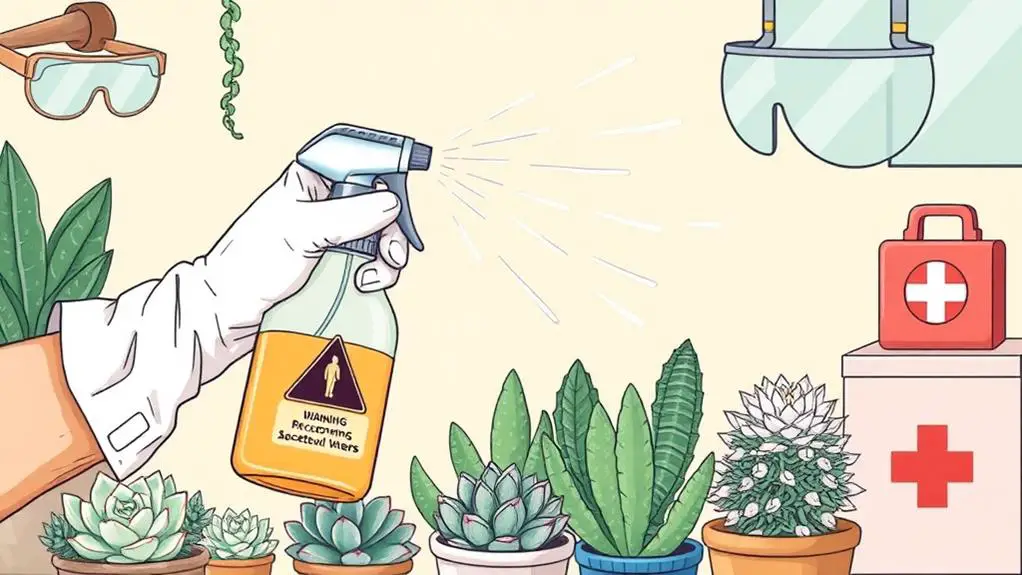
When using hydrogen peroxide with your succulents, always wear protective gloves and eyewear to keep your skin and eyes safe from irritation.
Make sure your workspace is well-ventilated to avoid breathing in any fumes.
These steps will help you handle hydrogen peroxide safely and effectively.
Proper Ventilation Practices
Guaranteeing the area where you're using hydrogen peroxide has proper ventilation is essential for safety. When you spray the solution on your succulents, it's important to have adequate airflow to prevent respiratory irritation and help the plants air dry effectively. Proper ventilation helps minimize inhalation of vapors and guarantees that any fumes dissipate quickly.
To achieve this, you should:
- Open windows or use a fan: Enhancing ventilation indoors can considerably reduce the concentration of hydrogen peroxide fumes.
- Avoid enclosed spaces: Never use hydrogen peroxide in areas without windows or proper air circulation, as this can lead to breathing issues.
- Opt for outdoor application: If possible, spray the solution outside or in a well-ventilated garage.
Storing hydrogen peroxide in a well-ventilated spot, away from direct sunlight, also helps maintain its effectiveness.
Remember, the goal is to guarantee that both you and your succulents stay safe and healthy. By following these simple steps, you create a safer environment and reduce the risk of respiratory irritation.
Protective Gear Usage
Maintaining proper ventilation is just one part of the safety equation when using hydrogen peroxide with your succulents. Equally important is protective gear usage. Always wear gloves when handling hydrogen peroxide. This protects your skin from potential irritation and chemical burns.
Make sure your gloves fit well and cover your wrists to prevent any splashes from reaching your skin. Safety goggles are also essential. They shield your eyes from splashes, especially when you're diluting or applying the solution. Even a tiny splash in your eye can cause discomfort, so don't skip this step. Your eyes are sensitive, and protection is key.
Ventilation matters, but it's not enough on its own. Hydrogen peroxide can release fumes, so open windows or use a fan to keep the air moving. This helps minimize inhalation risks.
In case the solution contacts your skin or eyes, rinse the affected area immediately with plenty of water. If irritation persists, seek medical attention. It's better to be cautious and get help rather than risk long-term damage.
Always store hydrogen peroxide in a cool, dark place, away from children and pets. This prevents accidental ingestion or exposure, keeping everyone safe.
Common Mistakes
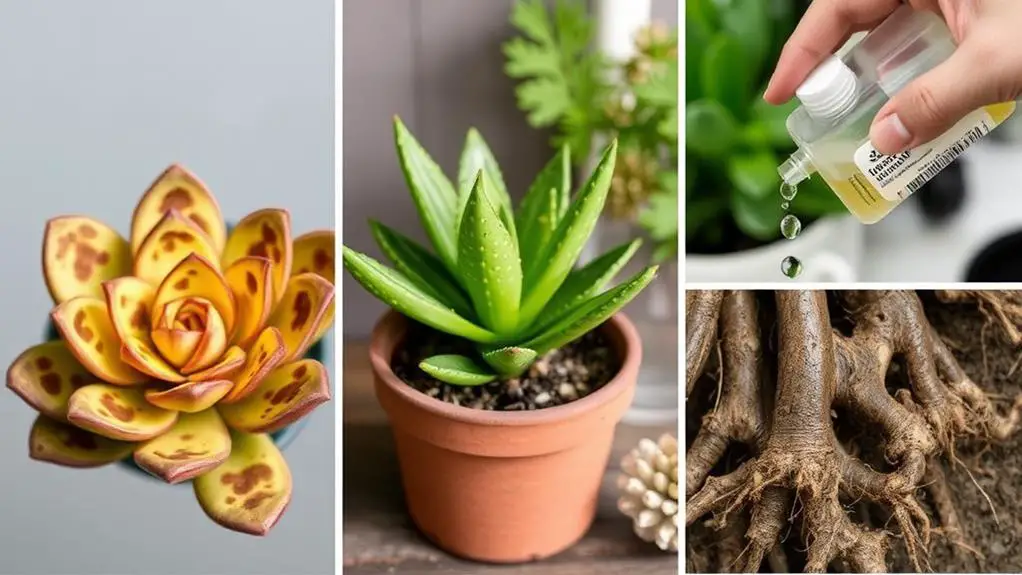
A common mistake when using hydrogen peroxide with succulents is failing to dilute it properly. When you don't dilute the solution, it can cause chemical burns and damage the succulent's cells, especially in sensitive species.
Always aim for a ratio of 1 part hydrogen peroxide to 10 parts water. This helps prevent root rot without harming the plant.
Another frequent error is applying hydrogen peroxide too often. While it can be beneficial, using it too frequently can damage roots and hinder growth.
Aim to use it every 2-4 weeks for maintenance. Overuse can also increase stress, particularly in newly transplanted or weak succulents, leading to plant health decline.
Here are some common mistakes to avoid:
- Not testing a small area first: Always test on a small part of the plant to check for adverse reactions.
- Overlooking different species' needs: Some succulents, like certain cacti, may require unique care when using hydrogen peroxide.
- Ignoring application frequency: Stick to the recommended frequency to avoid stressing your succulents.
Care Guidelines
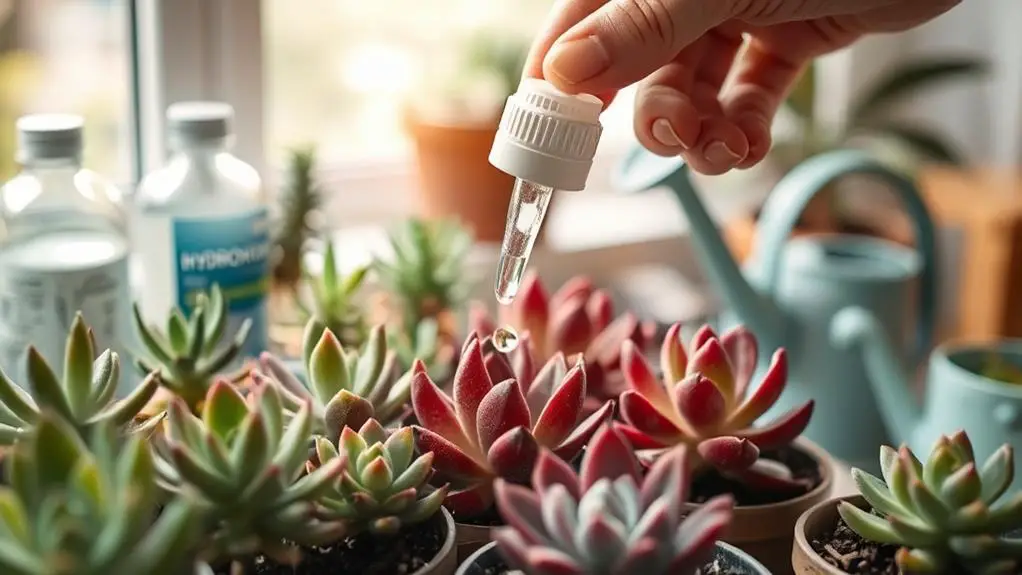
When caring for succulents, it is vital to follow specific guidelines to keep your plants thriving. First, maintain a consistent watering schedule, making sure the soil dries out completely between waterings to prevent root rot. Overwatering is a common issue, but it is easily avoidable with careful attention.
Adequate light is significant. Aim for bright, indirect sunlight for several hours a day. Insufficient light weakens plant cells, making them more susceptible to diseases. Using well-draining soil specifically formulated for succulents and cacti is another important step. This type of soil promotes healthy root development and prevents water retention, which can lead to root rot.
Regularly inspect your succulents for signs of pests or diseases, such as discoloration or wilting. Address these issues promptly to prevent further damage. Incorporate hydrogen peroxide treatments every 2-4 weeks. Properly diluted, hydrogen peroxide enhances root health and combats fungal infections without harming sensitive plant tissues.
| Guideline | Reason | Frequency |
|---|---|---|
| Consistent Watering Schedule | Prevents overwatering and root rot | As soil dries |
| Adequate Light | Guarantees strong plant cells | Daily |
| Well-Draining Soil | Promotes healthy root development | Always |
| Regular Inspections | Detects pests and diseases early | Weekly |
| Hydrogen Peroxide Treatment | Enhances root health | Every 2-4 weeks |
Frequently Asked Questions
How to Use Hydrogen Peroxide With Plants?
To use hydrogen peroxide with plants, dilute it with water, then spray the solution on leaves or soil. For severe issues, increase the concentration. Soak roots for root rot and always monitor for stress afterward.
How Often Should You Water Plants With Hydrogen Peroxide?
Water your plants with hydrogen peroxide diluted in water every 3-4 weeks to promote healthy roots and prevent fungal infections. Adjust the frequency based on the plant's needs, humidity, and soil moisture conditions. Always monitor their response.
How to Revive a Dying Plant With Hydrogen Peroxide?
To revive a dying plant with hydrogen peroxide, mix 1 part 3% hydrogen peroxide with 2 parts water. Soak the root ball for 10-15 minutes, rinse with distilled water, and guarantee well-draining soil. Repeat every 2-4 weeks.
How Do You Debug Plants With Hydrogen Peroxide?
To debug your plants with hydrogen peroxide, mix a 3% solution with water at a 1:1 ratio. Spray affected leaves and stems thoroughly. For soil pests, soak the soil with a 1:4 hydrogen peroxide to water solution.
Conclusion
You've got this! Using hydrogen peroxide with your succulents can be easy and effective. Just remember to dilute it properly, inspect your plants, and apply the solution as needed. Keep an eye on your succulents and repeat the treatment every 2-4 weeks. By following these steps, you'll help your plants stay healthy and vibrant. Don't worry if you're new to this—practice makes perfect. Happy gardening!

